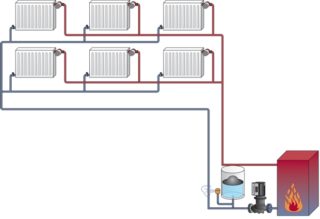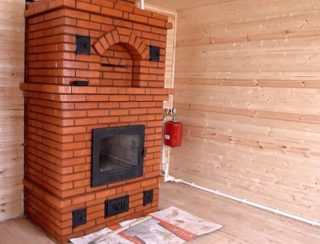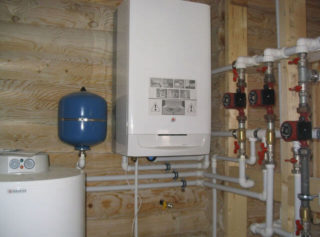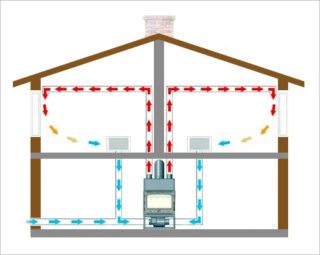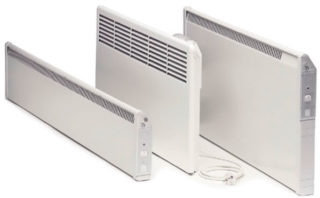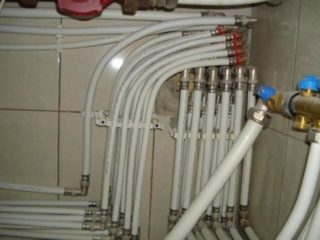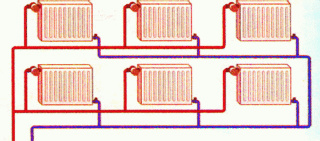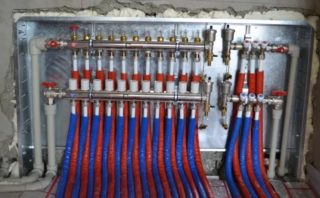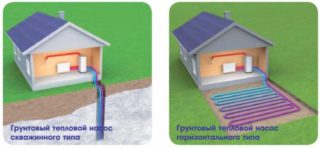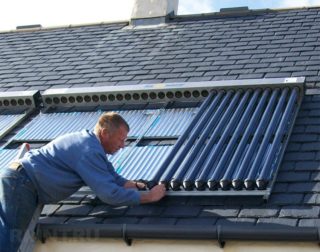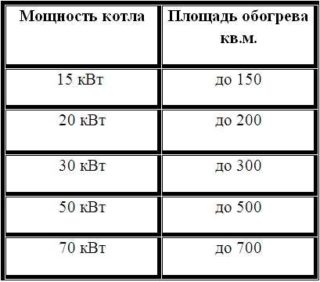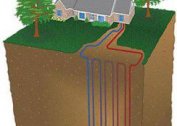High-quality heating communications in the home will reduce the risk of heat loss and provide support for a comfortable temperature. When planning heating in a private house, you need to choose the type of system, draw up a project, purchase materials. Independent laying of the heating main should be carried out in accordance with the recommendations of specialists and current standards.
Popular varieties of heating systems
Depending on the coolant used, there are several types of communications.
Steam heating
The main element of the main line is a boiler, where water boils, and steam is supplied to the house along a special circuit. Moving through pipes and radiators, the coolant cools down, comes into a liquid state and again moves into the tank. The system is equipped with a multi-apartment type of housing, industrial enterprises. In the private sector, due to the risks of explosion and fire, steam heating is not used.
Waterway
The difference between the water system is the use of natural and forced circulation of the coolant and the pressure difference of the circuits. When using forced circulation, a special pump is installed, for the natural one a tank is needed.
The principle of operation of the main consists in heating the water in the tank and its further supply through closed pipes and radiators. They heat the room. The heat carrier is heated by gas, liquid or solid fuel.
The advantages of water heating for a private house include:
- pipes and radiators heat up, but do not burn when touched;
- the rooms maintain the same temperature;
- fuel economy;
- long operational period;
- minimum noise level;
- ease of maintenance.
When choosing hydraulic heating, you need to consider the layout of the wiring, the connection diagram of the elements and the design of the risers.
Open fire
Stove heating is distinguished by autonomy, non-volatility. Depending on the needs of the owners, a fireplace or stove is set up to work on heating. Food can be cooked on the hob, and vegetables and fruits can be dried in the oven.
Using open fire as a heat source has several advantages:
- minimum costs for the purchase of materials for masonry and decoration;
- the possibility of combining a standard stove and fireplace;
- cozy atmosphere in the presence of live fire;
- integration of the structure into the bearing wall;
- saving on fuel resources.
The furnace method of generating heat requires space for the installation of a heating unit, which takes a very long time to heat up. First, the walls warm up, and then the air in the rooms.
Through the chimney, 50% of the useful thermal energy is expelled.
Gas communications
A floor or wall boiler is an economical method of heating if you have a suburban or private home. The highway operates on the principle of burning gas in a combustion chamber with the release of thermal energy. She heats the liquid coolant through a heat exchanger. The use of a gas system eliminates the cost of arranging the chimney and ensures maximum heat storage.
Depending on the purpose of the arrangement, the number of circuits is selected. A single-circuit tank can only heat the home, and a double-circuit tank can provide hot water.
Using a gas unit is beneficial for several reasons:
- fuel is not expensive;
- efficiency of heating systems;
- the system can be fully automated;
- lack of soot and ash during boiler operation;
- many boiler options.
The disadvantage of communications is the danger of maintenance and installation, the high cost of equipment and the need for special permits for its installation.
Air heating
A heating system without a coolant, which works by passing air through a heat generator and heating it. Air masses are sent to rooms through special channels. Cooling down, they go down, gather in the air intakes and are led out to the generator. At the heart of the functioning of the highway is forced (circulation pump) and natural (temperature difference of the flows) circulation.
For a private house, you can choose this type of communications:
- Local - an auxiliary option, implemented by special devices, fans and heat guns. The principle of their action is air recirculation.
- Central - suitable for buildings equipped with general ventilation. It is organized on the basis of direct-flow, partial or complete recirculation.
- Thermal veils - are mounted in openings, create an obstacle for cold air when opening a shutter.
Air communications reduce heat loss by 2 times.
Electric heating
Electricity is used to heat the floor, ceiling and walls. In a residential building, you do not need to put a boiler, the heat is distributed evenly. Manufacturers produce several types of equipment:
- TENOV and electrode. The coolant is heated by a heater or two electrodes. Differences of boiler plants - compactness and durability.
- Induction. It consists of magnetic and thermal circuits, which contributes to the rapid heating of the coolant and rooms. If necessary, the heating unit can be equipped with automatic control.
- Combined. An electric device can also work on another type of fuel, which is suitable for summer houses and villages.
All heating options can be combined.
Features of installing DIY heating in a private house
When arranging do-it-yourself heating in a house, you need to draw up a project. It reflects several points.
Type of pipeline
Installation of the following products is allowed:
- Steel. The metal material is characterized by high thermal conductivity, strength and affordable cost. Of the minuses - a lot of weight, the complexity of bending and susceptibility to corrosion processes.
- Copper. The pipe is used for an autonomous circuit, characterized by flexibility under the influence of high temperature, the absence of bumps on the internal walls. A closed circuit cannot be made of them - eddy currents will violate the tightness of the route.
- Polypropylene. Polypropylene without reinforcement is used for the manufacture of PP-H fittings, so it will not be suitable for hot water. PP-B is used for systems with a coolant not more than +50 degrees. Polypropylene PPRC-material has a reinforced middle layer and withstands high heat carrier temperature.
The minimum diameter of the heating pipes is 30 mm.
Number of radiators and sections
The SNiP says that the calculation is made depending on the area of the heated room.The document regulates 100 watts of heat per square meter, so the area must be multiplied by 100.
The number of sections depends on the degree of heat transfer of one element. It is indicated by the manufacturer. The amount of heat should be divided by the heat transfer coefficient, and the result should be transferred to radiators.
Installation and wiring diagram
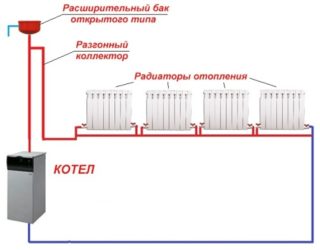
The piping is made according to the single-pipe or two-pipe principle.
Single pipe communications differ in simplicity of independent installation, the minimum expenses for materials. The device of the line involves the sequential delivery of the coolant - it exits the boiler, heading for the batteries in turn. Connection is made according to the following schemes:
- Horizontal The connection of radiators for the sequential movement of the thermal carrier is carried out one after another. The pipe is solid, not passed through the batteries. The disadvantage of the circuit is the inconsistent heating of the reinforcement.
- Vertical. Suitable for two-story buildings and provides for the withdrawal of a pipe with a heat source to the upper floor. There you will need to connect the batteries and make bends down. The disadvantage of the system is that the second floor is warmer than the first.
- Compensatory. Leningradka with bypasses jumpers that direct the coolant bypass. The cells are located under the batteries, which ensures uniform heat distribution and temperature control.
Leningradka can be implemented in a two-story and one-story building.
Double pipe circuit heating is a return and supply line, between which radiators are placed. The input is connected to the feed, and the output to the return. For masking communications, aligning and adjusting the temperature regime, wiring is used from above and below.
At bottom wiring plastic fasteners are used to lay the feed and return lines. In the presence of radiators with side connection, the outlet is made from the supply pipe to the upper side cavity. The coolant is taken from below. Air vents are mounted on radiators, an expansion unit is placed at the bottom.
Battery connection is diagonal, which increases the heat transfer coefficient. The circuit is closed, the tank is completely tight, the pressure pumps the circulation pump.
To heat a two-story house, pipes are mounted on both floors and parallel to the boiler.
At top cabling the expansion tank is placed at the highest point - under the ceiling or in the attic. The coolant from it is lowered into the batteries, and after the energy is released through the return pipe, it moves into the tank.
The upper system is a good reception for heating high-rise buildings, eliminates the cost of the slopes and allows you to run a highway with a natural type of circulation. The downsides are open pipes and the need for forced circulation in tall buildings.
Beam Collector Wiring: Each heating system is equipped with its own mains and two collectors for supply and return. From them to the batteries are individual straight pipes. The beam scheme has several advantages:
- compatibility with underfloor heating system;
- pipeline masking in the wall and floor surface;
- convenience of self-fulfillment;
- remote adjustment of each circuit;
- minimum number of joints;
- high-quality heat distribution.
It is problematic to implement collector wiring in the constructed dwelling, equipment and installation require large financial investments.
Alternative heating technologies
Alternative heating as auxiliary or fully autonomous can be installed by yourself. Several options are selected depending on the district’s energy supply and monetary capabilities.
Heat pumps
An electric device transforms the energy of natural resources and directs it to heating. Manufacturers produce such modifications:
- Soil - plunge into the ground and completely heat the house. Devices pay off in 10-15 years and provide for initial investments. For installation, you need a dirt collector system.
- Air - replace traditional heating, but ineffective at subzero temperatures. Air vents are suitable for off-season operation.
Two-tariff meters are compatible with heat pumps.
Solar collectors
Ancillary equipment, the effectiveness of which depends on the length of daylight hours. They are used for heating water in the summer, spring and autumn season. In winter, they support heating of the coolant, transferring the accumulated heat to a special tank.
Hybrid systems
Combine traditional and alternative options, which saves on heating. Most often found:
- Boiler + solar collector. The solid fuel unit and the solar panel support a comfortable microclimate and hot water supply. The boiler is turned on when there is a lack of solar energy. The option is convenient for large houses with underfloor heating.
- Boiler + heat pump. The system is represented by an external soil geothermal circuit with an indoor unit (evaporator, condenser, compressor) and storage tank. The pump circuit absorbs heat from the soil at a level of 2.5 m, transfers heat energy to the evaporator. The refrigerant collects heat, transferring it to water.
- Thermal station + heliosystem. Heating of air masses comes from underfloor heating and francoils. Water for hot water is heated in a heat accumulator. Heat from the geothermal circuit is supplied through a buffer or chain "evaporator - compressor - condenser".
Hybrid systems will pay off only after 10-20 years and are not suitable for areas with a cold climate.
The parameters of the correct choice of heating system for a private house
When choosing heating communications, you need to consider:
- The level of heat distribution. The rate depends on the room. In the bedroom it is optimal + 22-25 degrees, in the hallway - +12 degrees. The total temperature should be + 20-24 degrees.
- Heat loss. Most of the thermal energy flows through windows and doors, so they should be insulated.
- Place for mounting batteries. To reduce heat leakage through openings, it is better to put them under the window.
- Boiler power. For calculations, you need to summarize the battery power indicators, multiply the value by 1.4 and divide by the power factor and the efficiency of the unit.
- Fuel resources. For the stove and a special boiler, solid one is suitable - coal, firewood, briquettes. The system also runs on electricity, gas, liquid fuels, alternative sources.
Any shortcomings will reduce the quality of heating and the efficiency of the line.
In a private country house and in the country, it is easy to implement any heating system. The owner needs to choose the option with the maximum practicality, payback, in accordance with financial capabilities.
